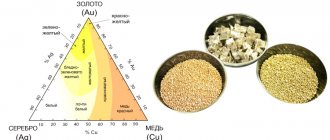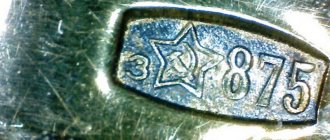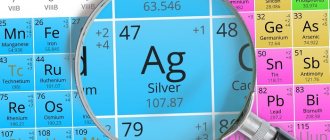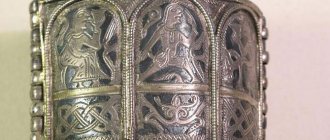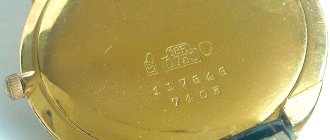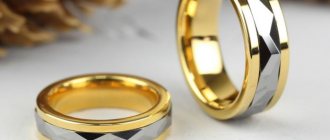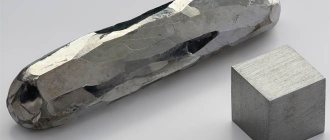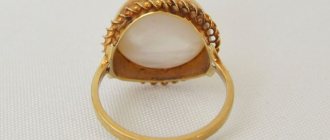Silver is found in nature 17 times more often than gold, so it is not surprising that man discovered the “lunar” metal earlier than the “solar” one, in the 4th millennium BC. e. This is confirmed by archaeological finds in Syria, Persia, China, and Egypt. Silver became a valuable metal for coinage, awards, tableware, religious objects and jewelry and was valued higher than gold for a long time.
From the point of view of physical properties, silver is a soft and malleable metal, that is, ductile: from 1 g of pure silver, a jeweler can get 2 km of the finest wire. To make products made from noble metal durable, it is turned into an alloy with a small amount of copper. There are only 70 mg of silver per 1 ton of rocks in the earth's crust. The total reserves of silver in the world are estimated at approximately 500–600 thousand tons.
The largest deposits of the precious metal belong to Peru, Chile, Mexico, Australia, Russia, Poland, Canada, USA, Bolivia, China and Japan.
№1
Since it has antibacterial properties, it has been used for medicinal purposes since ancient Greece. The ancient Greeks and Romans used this metal to prevent infection, and the stability of the Roman economy depended on the supply of this metal, which was mined at a rate of 200 tons per year.
In the Middle Ages, its antibacterial properties were also used to disinfect water and protect food during long-term storage.
Story
- When did you start using it?
Silver began to be used in the Bronze Age. In Sardinia it was used during the Copper Age. Silver is sometimes found in the form of nuggets and must be smelted from ores or other metals. In Russia, silver began to be mined on an industrial scale at the end of the seventeenth century.
- Use of silver in Ancient Egypt.
Silver plates have been used since ancient Egypt. They were applied to an open wound. It was believed that this could prevent suppuration and speed up the healing process. This treatment was effective because silver has bactericidal properties.
- The first currency in Rus'.
The first currency in Rus' was silver bars - hryvnias, which were cut into “rubles” if the cost of the goods was insignificant. It was difficult to divide the hryvnia into equal parts; one part came out longer, hence the phrase “chase a long ruble,” which means “to make a big profit by doing ordinary work.”
- Decline of the Ottoman Empire
The decline of the Ottoman Empire began in large part due to the flow of silver that the Spanish mined in Latin America. The value of this metal relative to gold fell tenfold, and the Ottoman economy, which was based on the silver coin “akçe,” suffered from this.
- The largest silver mine
Silver mines near the city of Potosi (Bolivia) produced almost 1 billion pesos worth of silver in the 16th and 17th centuries. The peso was a coin that weighed about 20 grams. The city of Potosi at the beginning of the 17th century had a population of 160 thousand people and was the largest city in America and the largest industrial center in the world.
City of Potosi
№2
They started mining it a long time ago. The first evidence of mining this metal dates back to 3000 BC. For the first time, mining of this metal began in the territory of modern Turkey and Greece. Ancient people even learned to separate silver from other metals. They smelted the ore and then blew air over it. This process is called cupellation. The noble metal does not react to oxygen, while copper and lead are oxidized and separated from the silver.
Records
- The largest metal nugget.
The largest nugget of white metal was found in the 15th century in the Ore Mountains. These mountains are located in Germany and the Czech Republic, the nugget was probably located in the German part of the mountains. The nugget had a mass of 20 tons and consisted of many nuggets fastened together.
- "Silver Sidewalk"
The longest silver plate was found in Canada, the length of which was 30 meters! It was nicknamed the “silver sidewalk.” This plate consisted of many nuggets fastened together.
- The richest country in silver.
The largest reserves of argentum are in India.
120 ton nugget, British Columbia
№6
You may have once heard the name “German silver”, also known as cupronickel. No. This is not some super test. On the contrary, cupronickel does not contain this noble metal at all. This is a popular alloy of copper and nickel (sometimes zinc), which is actively used in jewelry and decoration. This alloy is very similar in appearance to sterling silver, but does not tarnish and is more durable.
Bonus fact
Silver is an extremely popular metal in jewelry, and not only in its pure form, but also coated with another, no less popular, precious metal - gold. Not many people know, but gilded silver has its own name - vermeil.
Advertising - Continued below
Of course, the public has a controversial attitude towards it: some value it for its combination of a spectacular appearance with an affordable price, others consider such jewelry to be only an attempt to imitate the high cost, which disappears with the gradual wear and tear of the gold plating. Therefore, not all silver cleaning methods are suitable for vermeil.
Silver is not only a beautiful metal with a pleasant moonlit shine, which we are used to seeing as a jewelry material. Behind its attractive shell it still hides many secrets, and perhaps not all of them have been solved yet.
№7
As with gold, silver is found in the human body. However, scientists still have not understood what role this element plays in our body.
The highest concentration of this metal is observed in the human brain (0.03 mg per 1 kg).
Together with food, a person consumes about 0.1 mg of Argentum daily. Quite a lot of silver is contained in egg yolk (approximately 0.2 mg per 100 grams). It is excreted from the body mainly with feces.
Myths about silver
- Fake silver turns black, but real (old, high-quality) silver does not turn black
A fake can also turn black for a variety of reasons, but if you carefully read our article, you realized that the formation of a thin layer of silver oxide or sulfide is normal for this metal; this is its chemical feature. And in old jewelry, not copper, but palladium and platinum were used as ligatures. This alloy did not really darken, but it was much more expensive. It's chemistry, nothing personal.
- Silver disinfects
This is true, silver has bacteriostatic properties, slowing down the development of bacteria, and a bactericidal effect, killing bacteria with the help of silver ions. But this manifests itself only in concentration, which can be harmful for you and me, because silver is a heavy metal, it is deposited in the body and can cause poisoning. It is safe to wear, but we do not recommend eating it.
You can also remove spoons, rings and pendants from the water: in this case, so few silver ions are released that they are not able to disinfect anything. This also means you don't have to worry about silverware and cutlery. If you use a special ionizer, there will be an effect, but with it it is easy to exceed the permissible concentration and again get poisoned.
If you are reading in English, here is a WHO report on the use of silver for disinfection, which generally repeats the above conclusions and speaks of the lack of information for far-reaching conclusions in most studies on this topic.
- Silver drives away evil spirits
We invite you to check this myth yourself. Find a vampire and stab him with a silver sword, but take precautions: if the sword is rhodium-plated, the effect may be disappointing.
№8
If an increased amount of silver enters the human body for a long time, arginia will begin to develop. This is the coloring of mucous membranes and skin. With arginia, a person acquires a bluish tint to the skin.
It is worth noting that people who encounter arginia do not feel any discomfort in the body, naturally, with the exception of skin coloring.
Electrum
Another interesting fact about silver. Since time immemorial, the technology of purifying gold using molten lead has been known. This produced a metal that was first called “pale gold.” It differed from real gold in its pale color and higher density. For quite a long time, scientists considered it a special chemical element and even assigned it the Latin name “electrum”. Relatively recently it became clear that this is an alloy of two noble metals: silver and gold.
№9
This metal is mined in large quantities in countries such as Mexico and Peru. In Mexico in 2022, production volume amounted to 6.1 thousand tons. At the same time, reserves remained around 37 thousand tons. In Peru, production volume is 4.3 thousand tons, and reserves are 110 thousand tons. These countries are followed by China (3.6 production, 41 thousand tons of reserves) and Poland (1.3 production, and reserves of 110 thousand tons). As for Russia, it produces 1.2 thousand tons of silver, and reserves amount to 45 thousand tons.
Mirrors
Silver has the highest reflectance of light in the visible spectrum: 97%. And this is another interesting fact about silver. This is what is used to produce the best mirrors. For consumer goods, the mirror industry now uses aluminum, which is much cheaper these days. Previously, when there was no technology for mass production of aluminum, mirrors were made only on a silver base and they were very expensive. And the oldest mirror that exists today is approximately 5 thousand years old.
Currently, silver mirrors are used mainly for solar power plants, for example, they operate a solar thermal power plant in California.
№10
It has excellent reflectivity, reflecting about 95% of light. This is the highest value among all metals. It is for this reason that it is used to make high-quality glasses, telescopes, microscopes, etc.
Previously, all mirrors were made of silver. Today, aluminum is used to make them, as it is cheaper and does not fade over time.
Scope of application of silver
There are many applications for the material in question, which is why it has such a high cost and authority among the broadest masses of people.
Here are the main cases of its use:
- Technical applications in science and industry. Reliable contacts for electrical connections are treated with silver. Since the material melts at a very high temperature, almost 1000 degrees, it is used wherever it is important to withstand a high-temperature environment.
- The specific gravity of the substance allows it to be used in various solders; for example, copper-silver solder is very popular.
- Used among precious metals in the field of jewelry making.
- The metal is also used to create high-quality mirrors with increased reflectivity in microwave electrical engineering.
- Silver is known for its disinfecting properties, so it is used to purify water from germs.
In chemistry, there is more than one formula for using silver for science, the chemical industry and a host of other tasks. With its help, all kinds of tests are carried out, high-quality welds are made, and complex electronics are created.
№11
The country of Argentina is believed to get its name from the Latin Argentum, which translates to silver. Here is how it was. One day, the Italian navigator Sebastian Cabot met a sailor who claimed to have found a country in which there were mountains made of silver. Naturally, Sebastian Cabot was very interested in this. He went in search of her, but when he arrived in Argentina, he did not find these silver mountains. But the name stuck to this country.
Money
In Ancient Rus', silver bars often served as monetary equivalent. Silver ingots resembled wooden blocks. If the price for a product turned out to be lower than a silver bar, then it was cut into pieces and taken exactly as much as the purchase cost. Such chopped parts were called “rubles”, because they literally were such. This is where the name of Russian money comes from.
№12
We all know that silver, like gold, is a noble metal and it does not interact with water and oxygen. But why does it darken? It has long been believed that if a piece of jewelry made of this metal darkens on a person’s body, then the person must be damaged or have the evil eye. But from a scientific point of view, everything is somewhat different. Yes, it does not react to oxygen contained in the air. However, it reacts to traces of sulfur in the air. Black deposits on metal can also appear as a result of the dissolution of ozone on its surface.
We also recommend reading: Interesting facts about gold
Chemical properties
The maximum valence of the metal in question is 1, since it corresponds to the group number where it is found in the periodic table. Silver ions react weakly to other elements, including even sulfuric and hydrochloric acid.
The molar mass is 107.8 amu. (the weight of the atom is the same), the color of thin foil from pure material resembles purple, but if a nugget is taken, then it is bright light, silver.
Oxidation of the substance occurs extremely weakly and only under special conditions. To do this, you have to use plasma technologies, ozone or ultraviolet radiation treatment. The electron configuration of silver looks like this: 4d^10 5s^1. The crystal lattice is cubic, or to be more precise, face-centered cubic.
Medicine
Silver has a proven antiseptic and healing effect. Its presence is detrimental to more than 650 species of various microorganisms, including pathogenic bacteria. Now silver is widely used in Indian pharmacology. And since ancient times, silver dishes have been very popular. This was not a whim of the rich, many of whom could have afforded gold. But since ancient times it has been noticed that those who used silver utensils were much less likely to get sick. Nowadays, science has confirmed these wonderful properties of silver.
Appearance in nature
Silver is a fairly rare element in the earth's crust. Its abundance is estimated at approximately 0.1 parts per million. It is also found in sea water. Its abundance is thought to be about 0.01 parts per million.
Silver is usually found in combination with ores of other metals, especially lead. The most common silver ores are argentite (Ag 2 S); kerargyrite or “silver horn” (AgCl); proustite (3Ag 2 S ○ As 2 S 3 ); and pyrargyrite (Ag 2 S ○ Sb 2 S 3 ).
The world's largest silver producers are Mexico, Peru, USA, Canada, Poland, Chile and Australia. In the United States, silver is produced from approximately 76 mines in 16 states. The largest state producers are Nevada, Idaho and Arizona. These three states account for about two-thirds of all silver mined in the United States.


